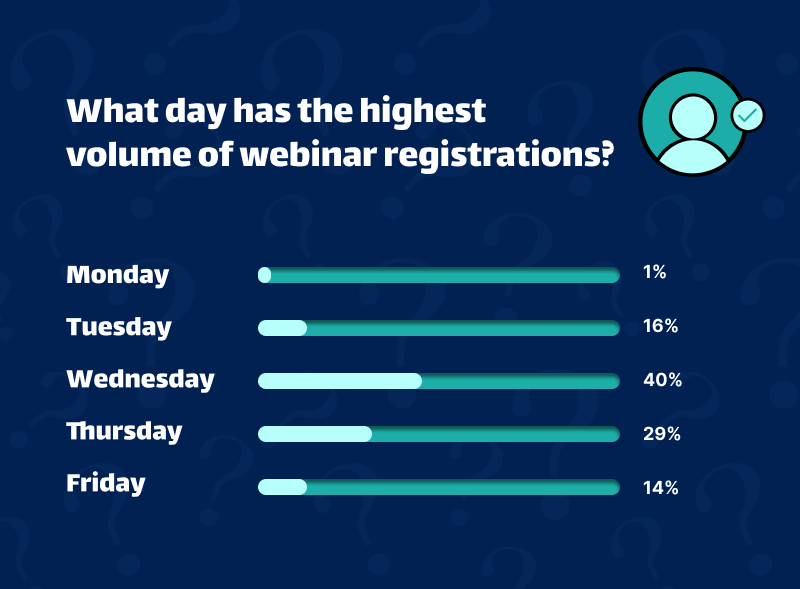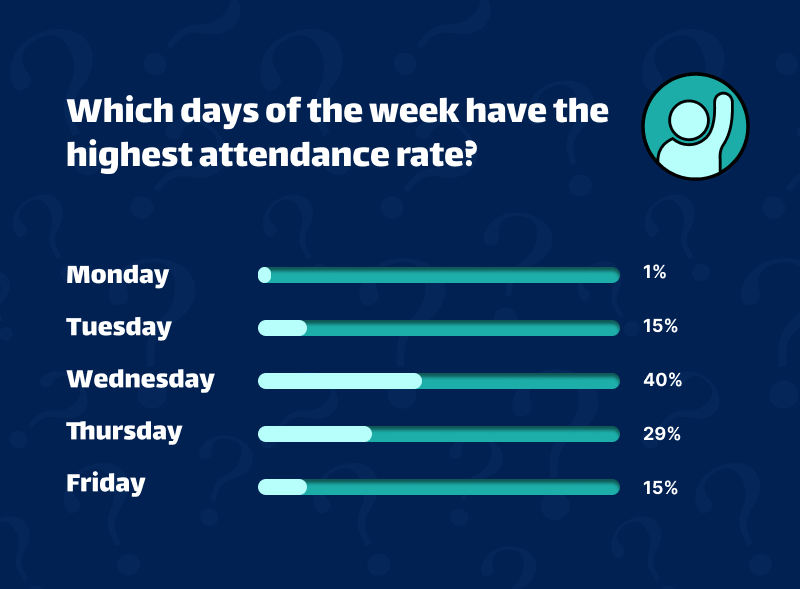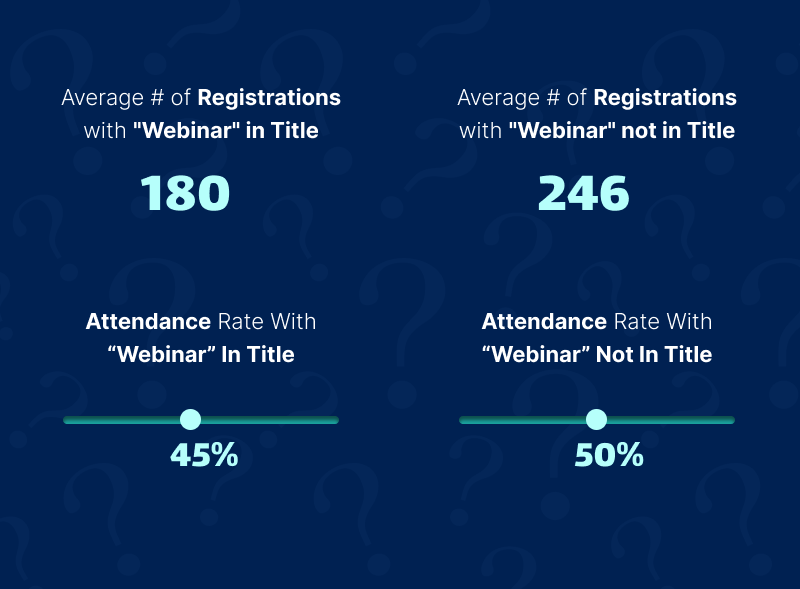What’s the Best Day To Host a Webinar? We Dug Into the Data, so You Don’t Have To

Maximize Your Marketing ROI
Join 10,000 other marketers already getting the best tips on running engaging events that boost pipeline and create raving fans.
When you're scheduling your webinars, how much thought do you put into what day and time to schedule them for? How do you know when people are most likely to attend?
Starting the week off with a webinar is a great way to capture fresh eyes, but are folks too busy playing catch-up to attend? What about mid-week, when folks are more attentive but might also have more meetings?
Mornings sound great—until you realize many people use their mornings to take care of their biggest tasks of the day. So you decide afternoons are a dream option—but then you wonder if people will be in the dreaded post-lunch slump and hard to engage.
Once you start mulling over it, it can seem impossible to get the timing right. No matter when you schedule it, you're bound to miss out on someone!
So, when’s the absolute best day and time to host a webinar?
The short answer here is: It depends.
Not quite what you wanted to hear, right? Allow us to provide some more context.
What are the most popular days to host a webinar?
For our first-ever Webinar Benchmark Report, we looked at a ton of data.
More specifically, we studied 900+ webinars hosted by 100 different B2B brands. Those events were signed up for by 370,000 people and actually attended by 118,000.
And … drumroll, please … here's what we discovered!

Most companies schedule events for the middle of the week. Wednesday is a crowd favorite, with Thursday right on its heels. This is probably because many people use Mondays to get organized for the week, and some people don't work at all on Fridays or may be on a three-day weekend on any given Friday.
On what day do most people sign up for webinars?
Here's where it gets really interesting: We also found that the days that people sign up for events the most also follow the same pattern as when the most webinars are scheduled!

Maybe this gives credence to what we just said—perhaps people have the most time on their hands mid-week, and that's when they're online searching for educational events.
And, with all of this in mind, it should then come as no surprise that the days of the week with the most-attended events are also in line with the other two trends.

No matter which way you slice it, you can't deny: Wednesdays and Thursdays are comin' in hot!
You don't have to follow the pack to be successful
A quick note: We don't want you to look at these numbers and think that you can only host and promote events mid-week. On the contrary, this could be a great argument for trying different days of the week because there are fewer events and companies out there competing with you!
📈 Want more data-driven webinar tips? Download the full Webinar Benchmark Report!
Here's why timing is tricky
As far as what time to schedule your event, there's no way to optimize for everyone. The right timing for your webinar will really depend on who you want to attend, where they live, and what their schedules generally look like.
A couple of things to keep in mind here:
- Everyone works differently. Some people pack their mornings with meetings, while others only meet during the afternoon. Some folks like to time-block on certain days and go meetings-free and heads-down into their work, while other people mix up their schedule day to day.
- Things pop up. Even with a dedicated calendar hold, things happen. Whether it's a last-minute meeting or a personal conflict, someone may sign up and then not be able to attend.
- Time is relative, especially with a remote workforce. A morning meeting for your East Coasters is going to be a really early morning for your West Coast people!
When you're figuring out what time to schedule events, think about your audience. When is your target persona generally free?
A good rule of thumb is: If your audience is primarily in the US, stick to start times between 10 AM West Coast time and 3 PM East Coast time. This is a range that helps you avoid the very beginnings and ends of everyone's day.
Note: Day and time aren't the only factors to consider
We've spent a lot of time talking about timing because, well, that's the focus of this blog! However, there are other factors that impact your registration and show rates, so you'll want to keep that in perspective.
For example, one big takeaway from our report was that what you name your webinar can impact how many people sign up. Surprisingly, the data showed that people don't respond well—at all!—to events that have the word "webinar" in the title.

That's right: People don't want to attend webinars that are called webinars.
We've got some theories on why this is, but what this means for you is you'll need to think expansively and come up with some alternative names for your events if you want to optimize to get the most registrants.
An on-demand strategy can complement your events
Alright! We've covered a lot of ground so far.
You now know that mid-week is when most webinars are hosted, signed up for, and attended. You also know there's no true way to optimize for what time your webinar should be. And, you know to steer clear of using the word "webinar" in your title.
What else do we want you to know? Well, webinars shouldn't be a "one and done" affair—and you should plan ahead to have your webinar content available on demand for attendees (and others!).
In fact, our data shows that 98% of digital event attendees expect to be able to access the content afterward. We have to give the people what they want, right?
You have a few options here:
- Host the event “on-demand” directly in your event platform. This is a low-lift way to ensure your webinar is still accessible long after the cameras stop rolling.
- Host webinars on a webpage. Many folks like to do recaps that hit on the highlights and embed the webinar video on the blog page. Or, you could repurpose the webinar registration page to capture leads and simply “ungate” a video embed after the event.
- Host webinars in a dedicated video library. If you have a lot of webinar content, you might want to spin up a dedicated library. This way, folks can easily navigate to one place and find all of your webinars on demand.
Once you've got your on-demand webinars up and running, share that information with your sales team so that they can use the links in outreach and prospect conversations!
You can also use your on-demand webinars to bolster your marketing strategy. For example, if your webinar is part of a larger integrated campaign, you can promote the on-demand webinar with other campaign assets.
On-demand assets also make great paid advertisements; build out campaigns that map to the webinar's target audience and use the webinar for lead generation or retargeting.
The time is right to experiment
The best angle to approach this from is the "try-angle" … see what we did there?
In other words: Just try different things! Mix it up. Schedule your event for a less popular day or time and see what happens. Experiment with different formats, various session lengths, and more.
Take notes until you figure out what works best for you. You might be totally surprised and stumble into a completely unique approach that works for your target audience and only your target audience. Yay for finding your way!

Transform Your Video Marketing with AI
Stay In Touch
Platform
Resources
© 2025 Copyright Goldcast, Inc. All rights reserved.





 Upcoming Events
Upcoming Events Event Series
Event Series On-Demand Events
On-Demand Events

